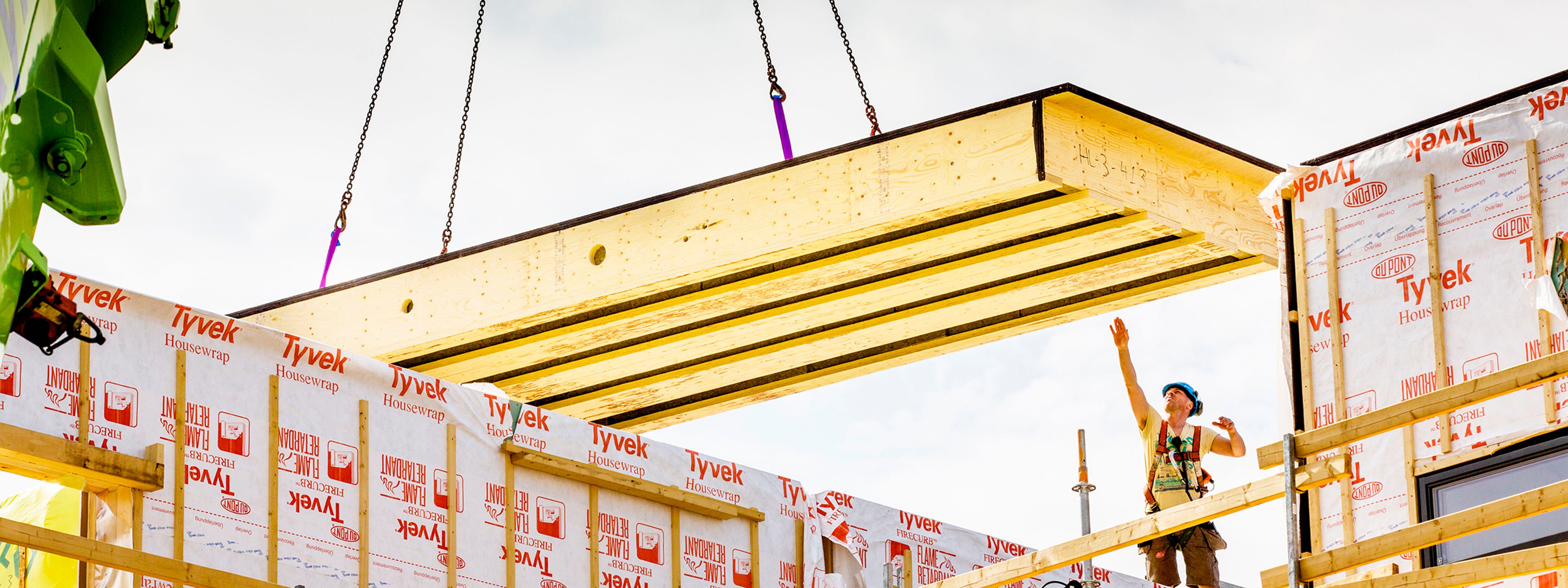AFRY Management Consulting has prepared a comparative study on the carbon footprint of Metsä Wood’s Kerto® LVL (Laminated Veneer Lumber) product. The report highlights the climate benefits of Kerto LVL compared to traditional steel reinforced concrete in certain floor and wall structures. The study compares load-bearing structures, excluding insulations or other materials, to ensure a fair assessment of primary structural components. As a conclusion, the material efficiency of Kerto LVL results in remarkably smaller fossil climate impact per square meter. The study was critically reviewed by Research institutes of Sweden, RISE and Ramboll.
Material-efficient floor structure results in over 70% lower climate impact compared to a concrete floor element
The study reveals that Kerto LVL offers a substantial reduction in carbon emissions when steel reinforced floor element is compared to wooden floor elements utilizing the Kerto-Ripa technology developed by Metsä Wood. “In this case, the material efficiency of Kerto LVL results in over 70% smaller fossil climate impact per m2 as the fossil climate impact per m2 of floor for Kerto LVL is 29 kg CO2e, while in-situ casted steel reinforced concrete slab has a fossil climate impact of 105 kg CO2e. The material consumption per m2 of floor for Kerto LVL is only 34 kg, compared to 675 kg for reinforced steel concrete. The difference in weight is over 90%”, explains Rosa Zabihian, Sustainability Manager from Metsä Wood.
Hybrid wall structure with Kerto LVL cuts material use by over 80% and lowers climate impact
In wall applications, the study focuses on a functional unit of 1 m2 of wall on the first floor in an 8-story building. The study compared the load-bearing inner core panels of two elements: a conventional concrete sandwich element and a hybrid element with Kerto LVL replacing steel reinforced concrete. The fossil climate impact per m2 of wall for Kerto LVL is 52 kg CO2e, while steel reinforced concrete has a fossil climate impact of 68 kg CO2e per m2. The fossil climate impact per m2 of wall from the whole life cycle of Kerto LVL is over 20% smaller compared to steel reinforced concrete. The material consumption per m² of wall for Kerto LVL is 60 kg, compared to 463 kg for reinforced steel concrete meaning over 80% less use of material in weight.
Material choices make a difference
The results highlight the climate advantages of floor and wall structures built resource efficiently with Kerto LVL. This can help identify emission reduction opportunities in construction projects. Kerto LVL can significantly reduce the carbon footprint of building projects compared to steel reinforced concrete. “Design and material choices made in the early stages of a construction project are crucial to maximizing material efficiency and achieving the best environmental outcomes”, Rosa Zabihian continues.
Metsä Wood is continuously seeking new ways to reduce the life cycle emissions of their products and applications where Kerto LVL is used. Innovative, material efficient and low-emission construction applications are developed together with other material and solution suppliers in the construction industry.
Read more
Media files
About the study
The comparative lifecycle assessment study (fossil GWP) was done by AFRY and 3rd party verified by RISE (Research Institutes of Sweden) and Ramboll (2024). The study included all phases of products’ life cycle, from raw material sourcing to end-of-life (“cradle to grave”) excluding credits from energy and material recovery. The building site was assumed to be in Central Europe, with locally produced concrete and Kerto LVL produced in Finland and transported to Central Europe. It is important to note that there can be significant differences in the carbon footprints of individual products within the same product category, depending on the producer. The comparative study was carefully structured to ensure an equitable evaluation of both alternatives, striving for maximum fairness and objectivity. Thus, published comparisons focus on GWP-fossil impact do not include credits from end-of-life when burning wood for energy. Also, carbon storage of wood is excluded from the comparison. For concrete an average EPD value from Betoniteollisuus ry (Association of Concrete Industry in Finland) was used and for Kerto LVL values from its EPD published in 2020 were used. The concept of EPDs is based on the standard ISO 14025. For material consumption per application 5 meter span was used to floor application and load-bearing lower floor for an 8-story building was used for wall application. Material consumption of steel reinforced concrete was defined by AFRY’s structural engineer. The compared GWP-fossil values per cubic meter of the material were quite similar for Kerto LVL and steel reinforced concrete thus the good result of Kerto LVL is driven by its light weight and high strength-to-weight ratio. LCA report is available on request.

For more information, please contact:
Henni Rousu, Marketing Director, Metsä Wood
tel. +358 40 554 8388, henni.rousu@metsagroup.com
Subscribe to our news
Fill in the formLatest news
-
Test production is starting at new Äänekoski Kerto LVL mill
Releases – 23.09.2025 -
Prefabricated wooden elements are cost-efficient and streamline the whole construction process
Releases – 15.05.2025 -
Metsä Group will build a Research and Development laboratory for veneer-based wood products
Releases – 29.04.2025